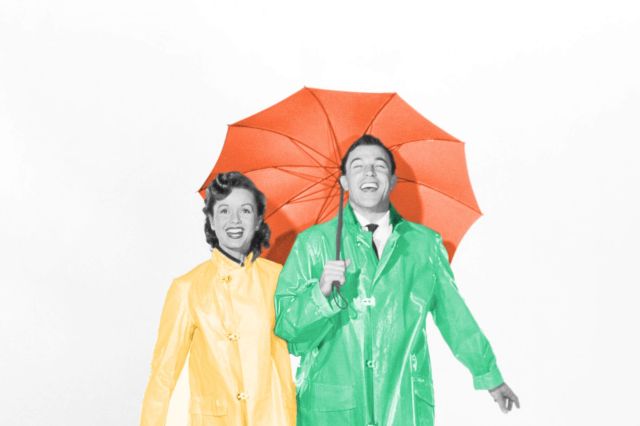
The Soundtrack Mostly Consisted of Well-Known Songs
Co-written by Adolph Green and Betty Comden, Singin’ in the Rain was essentially a vehicle for recycling a catalog of old songs created by the film’s producer, Arthur Freed, and his longtime composing partner, Nacio Brown. Although it’s now closely associated with Kelly’s iconic dance number, the film’s title track was written in the late 1920s and appeared in at least seven MGM films overall. Other tracks, like “All I Do Is Dream of You” and “You Were Meant for Me,” were also featured in previous pictures and recorded by multiple artists. According to Singin’ in the Rain: The Making of an American Masterpiece, the only new pieces written for the film were “Moses Supposes” — with the lyrics partly lifted from 19th-century English nonsense verse — and “Make ‘Em Laugh” — which bore a strong resemblance to the Kelly-performed “Be a Clown” from 1948’s The Pirate.

Debbie Reynolds Endured Harsh Training From Gene Kelly
A 19-year-old with limited screen and dance experience when she was cast for the role of Kathy Selden, Debbie Reynolds learned the hard way what it was like to work with a top-notch pro like Kelly. The film’s nimble-footed lead was relentless when it came to training his romantic co-star, who at one point was found sobbing beneath a rehearsal studio piano by Fred Astaire. The day-long shooting for the “Good Morning” dance scene reportedly left her with bloody feet, a grueling experience rendered unnecessary when Kelly wound up using the first take. Although she later gave Kelly credit for whipping her into shape, Reynolds also compared the making of the movie to childbirth, saying they were the “two hardest things” she’d ever done.

Gene Kelly Battled a Fever While Shooting the “Singin’ in the Rain” Sequence
Although he seems happy as a clam during his title-track song-and-dance scene, Kelly was feeling less than glorious while gritting through his moves in a wool suit with a 103-degree fever. Of course, he didn’t have the luxury of taking much time off to recover, so, according to his wife, he relaxed in the sunlight between takes to “just kind of bake this fever out of him.” Another problem affecting the scene was the amount of water needed to simulate a rainstorm. Although a network of pipes normally ensured that Kelly was sufficiently drenched, filming had to pause when local residents watered their lawns in the late afternoon and caused the set’s flow to dim to a trickle.
More Interesting Reads

Reynolds’ Voice Was Dubbed for Two Songs and One Speaking Scene
Naturally, in a movie that spotlights Hollywood’s use of uncredited singers supplying voice work for its headlining talents, there’s an uncredited singer supplying voice work for a headlining talent. As described in The Making of an American Masterpiece, Reynolds’ solo performance for “Would You?” and her duet with Kelly on “You Are My Lucky Star” were both dubbed by actress Betty Noyes. Furthermore, in the scene where Reynolds’ Kathy Selden is recording the spoken lines to be used by Hagen’s screechy Lina Lamont, that’s actually Hagen’s real voice being used.
“Make ‘Em Laugh” Was Strung Together From Donald O’Connor’s Bag of Tricks
A standout number in a film bursting with standout numbers, “Make ‘Em Laugh” differed from the other Kelly-choreographed sequences in that it was pieced together with bits from O’Connor’s days as a vaudeville star. Per An American Masterpiece, this included stunts such as the backflip off the wall — performed in two of his previous movies — and the running-in-circles-on-the-floor gag, borrowed from Jerry “Curly” Howard of the Three Stooges. Several sources, including O’Connor, have claimed that he was bedridden with exhaustion after shooting the scene, and then had to shoot it again because the original footage was ruined, although O’Connor contradicted himself when he told Roger Ebert in 2003 that those travails were fabricated.

The Film Was Initially Overshadowed by Another Kelly Feature
Although it was generally well reviewed and turned a profit at the box office, Singin’ in the Rain was hardly considered an instant classic. That’s partly because it was overshadowed by Kelly’s previous musical, An American in Paris (1951), which claimed a whopping eight Oscars at the March 1952 Academy Awards. (Singin’ in the Rain won zero Oscars the following year.)
Within a few decades, however, Singin’ had surpassed An American in Paris as the defining musical of its time. Among the accolades that burnished its legacy, Singin’ was among the 25 motion pictures selected for the brand-new National Film Registry in 1989, and it ranked No. 5 on the American Film Institute’s 100 Years … 100 Movies (10th Anniversary Edition) list in 2008.












